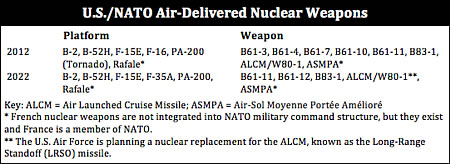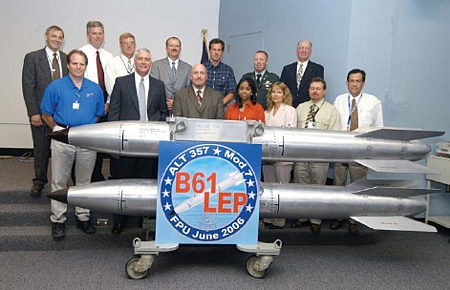 |
| The expected cost of the B61 Life-Extension Program has increased by 50 percent to $6 billion |
.
By Hans M. Kristensen
The expected cost of the B61 Life-Extension Program (LEP) has increased by 50 percent to $6 billion dollars, according to U.S. government sources.
Only one year ago, the National Nuclear Security Administration (NNSA) estimated in its Stockpile Stewardship and Management Program report to Congress that the cost of the program would be approximately $4 billion.
The escalating cost of the program – and concern that NNSA does not have an effective plan for managing it – has caused Congress to cap spending on the B61 LEP by 60 percent in 2012 and 100 percent in 2013. The Pentagon’s Cost Assessment and Program Evaluation (CAPE) office is currently evaluating NNSA’s cost estimate and is expected to release its assessment in July. After that, NNSA is expected to release a validated cost, schedule and scope estimate for the B61 LEP, a precondition for Congress releasing the program funds for Phase 6.3 of the program.
Ambitious Program
Beyond mismanagement, the 50 percent increase is due to the ambitious modifications that NNSA, the nuclear laboratories, and the Pentagon say are needed to extend the life of the bomb.
That includes new use-control and safety features to increase the surety of what is already the most safe warhead design in the stockpile. Several warhead design options were proposed, ranging from a simple life-extension with the current features to a significantly altered design with new optical wiring and multi-point safety. The Nuclear Weapons Council in December chose the second-most ambitious design without optical wiring and multi-point safety.
Expectation for the ambitious B61-12 program has already spawned a hiring frenzy at Sandia National Laboratory for a program that dwarfs the W76 LEP, the ongoing production of one of the navy’s Trident missile warheads. “It is the largest effort in more than 30 years, the largest, probably, since the original development of the B61-3,4,” according to the head of the B61 LEP at Sandia.
Program Justification
The Pentagon is promoting the consolidation of four B61 versions into the B61-12 as an effort to increase efficiency and lowering costs. But we have yet to see the budget justification for that and it is not clear how much of the savings will come from consolidation or from simply reducing the overall number of B61s in the stockpile. Already the consolidation part is turning out to be much more expensive than we were led to believe.
The B61 LEP was catapulted forward by the April 2010 Nuclear Posture Review, which committed – before a validated cost, schedule and scope estimate had been developed – the United States to conduct a “full scope” B61 LEP. That commitment came as part of a “deal” that promised significant investments in nuclear weapons modernization in return for Congressional approval of the New START treaty.
The Mission
The administration says that the B61 LEP is needed to provide nuclear extended deterrence to NATO allies and to continue a gravity bomb capability on the B-2 stealth bomber. According to the U.S. Air Force, the B61-12 is “critical” to “deterrence of adversaries in a regional context, and support of our extended deterrence commitments.”
But privately, U.S. Air Force officials do not see a need to continue the deployment in Europe, where the United States currently deploys nearly 200 B61-3/4 bombs in 87 aircraft shelters at six bases in five countries. And although the NATO Summit later this month is expected to endorse – for now – continuation of the current nuclear posture in Europe, none of the European allies appear to be willing to pay for continuing the mission.
Extended deterrence can be provided with other means and the B61-12 is not the only U.S. air-delivered nuclear weapon system. Indeed, the U.S. Air Force currently has seven different nuclear weapons for delivery by five different delivery platforms. After completion of the B61-12 program, the Air Force will still have four different nuclear weapons for delivery by five different aircraft.
 |
| The U.S. Air Force has six different nuclear weapons for delivery by five different aircraft. After the B61 LEP it will still have four weapons for five aircraft. |
.
Why so many different ways of delivering a nuclear weapon from the sky is needed for deterrence is anyone’s guess. The nuclear redundancy in the bomber leg is significantly greater than for ICBMs and SLBMs and appears to be the result of a combination of a left-over Cold War mission in Europe and requirements developed by warfighters to hold a variety of targets at risk in a variety of different ways.
Conclusions
After having spent hundreds of millions of dollars between 2006 and 2010 on extending the service life of the secondary of the B61-7 (and adding new spin-rocket motors to improve performance), NNSA and DOD are now planning to scrap the weapon and replace it with the $6 billion B61-12.
Although the cost estimate of the B61 LEP has increased by 50 percent over the past year, the $6 billion price tag is only part of the cost. The new guided tail kit the Air Force is developing to increase the accuracy of the B61-12 is expected to cost about $800 million. And the cost of making the F-35 Joint Strike Fighter capable of delivering the bomb is estimated to add another $340 million.
 |
| After having spent hundreds of millions of dollars on refurbishing the B61-7, NNSA now plans to scrap the weapon and replace it with the B61-12. |
.
The anticipated cost of the B61-12 program is now greater than the high-end cost estimate for the CMRR-NF, the plutonium pit production factory planned at Los Alamos that the Senate recently decided to mothball for at least five years due to its high cost. Or if that is not impressive enough, the cost of the B61 LEP is comparable to what NNSA plans to spend on sustaining the entire active stockpile for the next decade.
This level of nuclear cost increase and mismanagement is neither justifiable nor sustainable. It shouldn’t be normally, but it certainly isn’t in the current financial crisis. And all of this to sustain a nuclear deployment is Europe that may well end before the B61 LEP is completed and a nuclear capability on the B-2 bomber that already carries another nuclear bomb.
The current B61-12 program should be stopped and reassessed to reduce cost and scope. Congress has already asked the JASONs to examine the scope of the program and provide an assessment of any major concerns. In the meantime, the mission in Europe should temporarily be sustained with a much more basic life-extension program while the administration works to convince NATO to agree to a withdrawal of the remaining U.S. nuclear weapons from Europe. The nuclear capability of the B-2 bomber should be limited to what it already carries.
See also report: Non-Strategic Nuclear Weapons
This publication was made possible by a grant from Carnegie Corporation of New York and Ploughshares Fund. The statements made and views expressed are solely the responsibility of the author.
Satellite imagery has long served as a tool for observing on-the-ground activity worldwide, and offers especially valuable insights into the operation, development, and physical features related to nuclear technology.
This report outlines a framework relying on “Cooperative Technical Means” for effective arms control verification based on remote sensing, avoiding on-site inspections but maintaining a level of transparency that allows for immediate detection of changes in nuclear posture or a significant build-up above agreed limits.
The grant comes from the Carnegie Corporation of New York (CCNY) to investigate, alongside The British American Security Information Council (BASIC), the associated impact on nuclear stability.
Satellite imagery of RAF Lakenheath reveals new construction of a security perimeter around ten protective aircraft shelters in the designated nuclear area, the latest measure in a series of upgrades as the base prepares for the ability to store U.S. nuclear weapons.